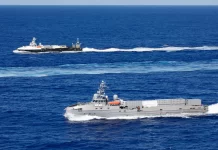The Boeing MQ-25 Stingray is the result of the Carrier-Based Aerial-Refueling System program
The US Navy’s MQ-25 Stingray program is taking new steps. According to the US Navy, the “MQ-25 will be the world’s first operational, carrier-based unmanned aircraft and is integral to the future carrier air wing (CVW),” and that the MQ-25 “will provide an aerial refueling capability that extends the range, operational capability, and lethality of the CVW (carrier air wing) and carrier strike group (CSG).”
During the Navy’s recent deck drills with the MQ-25, the Unmanned Aerial Vehicle (UAV) “completed a series of test points that evaluated the functionality and capabilities of the deck handling system during both day and nighttime operations.” The Navy began deck trials earlier this month.

Before that, the experimental prototype MQ-25 T1 had successfully tested for the first time in-air refueling. The test flight took place on June 4, and successfully refueled the US Navy’s F/A-18F Super Hornet.
The Boeing MQ-25 Stingray is the result of the Carrier-Based Aerial-Refueling System program, which grew out of the earlier Unmanned Carrier-Launched Airborne Surveillance and Strike program. The first flight was made on September 19, 2019. The MQ-Stingray is shaping up to be an important new project for the Navy. Refueling at sea and in the air is crucially vital and allows Navy planes to remain in the air and on station for extended periods of time.
Boeing’s MQ-25 design is powered by one Rolls-Royce AE 3007N turbofan engine delivering 10,000 lbf (44 kN) of thrust; this is a variant of the engine used to power the Navy’s MQ-4C Triton. The aircraft is less stealthy than flying wing UAVs. It does feature a stealthy fuselage shaping, flush inlet to shield engine blades from radar and V-tail.
One of the United States’ premiere aircraft, the F-35 Lightning II stealth fighter, has sustained criticism, with detractors pointing to the airplane’s combat radius as a serious weakness inherent to the plane. That is a gap the Stingray could fill.
Earlier this year, an MQ-25 topped off an F-35C Lightning II in the air over Illinois, a program first. The Navy explained that they would like the Stingray to eventually be able to refuel all Navy aircraft currently capable of receiving fuel in the air, providing greater operational flexibility.
Every test brings the Stingray closer to becoming fully mission capable. And, once operational, the Stingray will become the world’s first unmanned aerial refueling aircraft – A significant advantage for Naval aviation.























